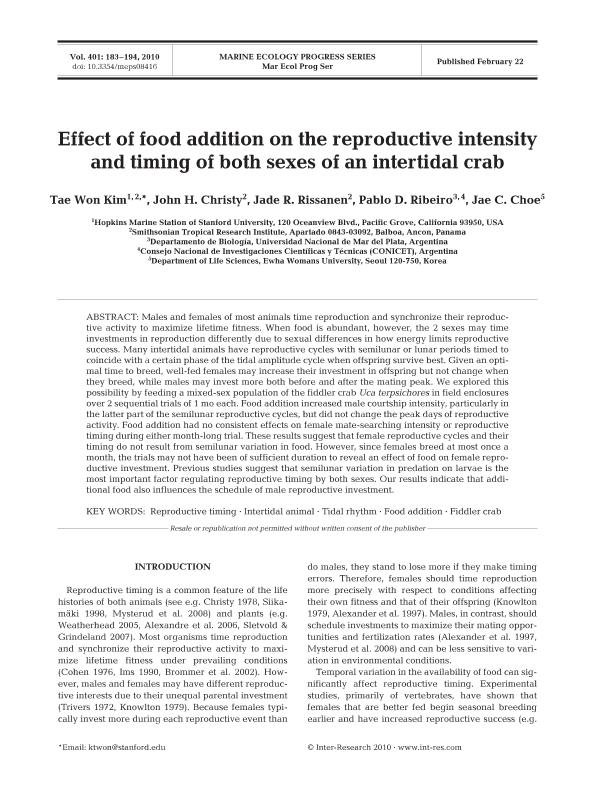Mostrar el registro sencillo del ítem
dc.contributor.author
Kim, Tae Won
dc.contributor.author
Christy, John H.
dc.contributor.author
Rissanen, Jade R.
dc.contributor.author
Ribeiro, Pablo Damián

dc.contributor.author
Choe, Jae C.
dc.date.available
2020-03-17T21:32:51Z
dc.date.issued
2010-02
dc.identifier.citation
Kim, Tae Won; Christy, John H.; Rissanen, Jade R.; Ribeiro, Pablo Damián; Choe, Jae C.; Effect of food addition on the reproductive intensity and timing of both sexes of an intertidal crab; Inter-Research; Marine Ecology Progress Series; 401; 2-2010; 183-194
dc.identifier.issn
0171-8630
dc.identifier.uri
http://hdl.handle.net/11336/99954
dc.description.abstract
Males and females of most animals time reproduction and synchronize their reproductive activity to maximize lifetime fitness. When food is abundant, however, the 2 sexes may time investments in reproduction differently due to sexual differences in how energy limits reproductive success. Many intertidal animals have reproductive cycles with semilunar or lunar periods timed to coincide with a certain phase of the tidal amplitude cycle when offspring survive best. Given an optimal time to breed, well-fed females may increase their investment in offspring but not change when they breed, while males may invest more both before and after the mating peak. We explored this possibility by feeding a mixed-sex population of the fiddler crab Uca terpsichores in field enclosures over 2 sequential trials of 1 mo each. Food addition increased male courtship intensity, particularly in the latter part of the semilunar reproductive cycles, but did not change the peak days of reproductive activity. Food addition had no consistent effects on female mate-searching intensity or reproductive timing during either month-long trial. These results suggest that female reproductive cycles and their timing do not result from semilunar variation in food. However, since females breed at most once a month, the trials may not have been of sufficient duration to reveal an effect of food on female reproductive investment. Previous studies suggest that semilunar variation in predation on larvae is the most important factor regulating reproductive timing by both sexes. Our results indicate that additional food also influences the schedule of male reproductive investment.
dc.format
application/pdf
dc.language.iso
eng
dc.publisher
Inter-Research

dc.rights
info:eu-repo/semantics/openAccess
dc.rights.uri
https://creativecommons.org/licenses/by-nc-sa/2.5/ar/
dc.subject
FIDDLER CRAB
dc.subject
FOOD ADDITION
dc.subject
INTERTIDAL ANIMAL
dc.subject
REPRODUCTIVE TIMING
dc.subject
TIDAL RHYTHM
dc.subject.classification
Ecología

dc.subject.classification
Ciencias Biológicas

dc.subject.classification
CIENCIAS NATURALES Y EXACTAS

dc.title
Effect of food addition on the reproductive intensity and timing of both sexes of an intertidal crab
dc.type
info:eu-repo/semantics/article
dc.type
info:ar-repo/semantics/artículo
dc.type
info:eu-repo/semantics/publishedVersion
dc.date.updated
2020-01-28T15:02:01Z
dc.journal.volume
401
dc.journal.pagination
183-194
dc.journal.pais
Alemania

dc.journal.ciudad
Oldendorf/Luhe
dc.description.fil
Fil: Kim, Tae Won. Smithsonian Tropical Research Institute; Panamá. University of Stanford; Estados Unidos
dc.description.fil
Fil: Christy, John H.. Smithsonian Tropical Research Institute; Panamá
dc.description.fil
Fil: Rissanen, Jade R.. Smithsonian Tropical Research Institute; Panamá
dc.description.fil
Fil: Ribeiro, Pablo Damián. Universidad Nacional de Mar del Plata; Argentina. Consejo Nacional de Investigaciones Científicas y Técnicas; Argentina
dc.description.fil
Fil: Choe, Jae C.. Ewha Womans University; Corea del Sur
dc.journal.title
Marine Ecology Progress Series

dc.relation.alternativeid
info:eu-repo/semantics/altIdentifier/doi/http://dx.doi.org/10.3354/meps08416
dc.relation.alternativeid
info:eu-repo/semantics/altIdentifier/url/http://www.int-res.com/abstracts/meps/v401/p183-194/
Archivos asociados
